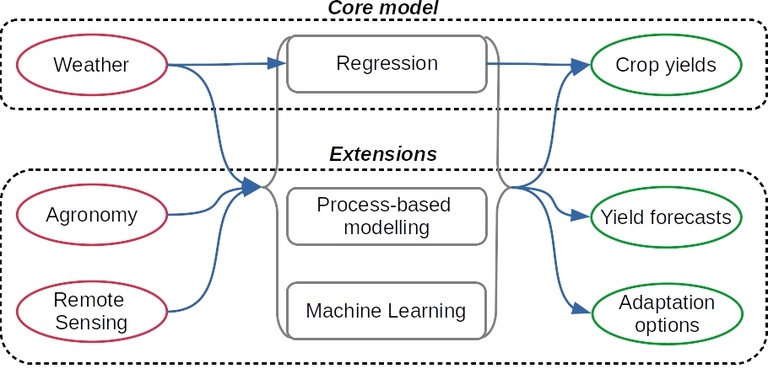AMPLIFY is a suite of crop models used to estimate or forecast yields and to derive adaptation options.
What does the model do?
The tool makes use of statistical and process based models using historical weather and yield data as well as remote sensing information to remotely assess crop yields and yield losses. The tool crucially differentiates between climate-related and non-weather-related (agronomic management, socio-economic) yield perils. By combining re-analysed weather and remote sensing data, AMPLIFY innovatively assesses yield losses on scales ranging from fields up to national level. The model scheme is shown below: while the core model uses weather data in a regression model to estimate crop yields, extensions in input data, model types and outputs are continuously added.
AMPLIFY is frequently used and maintained by the Working Group Adaptation in Agricultural Systems at PIK, contributing yield forecasts to several scientific and policy-relevant projects.

Fig. 1: The AMPLIFY model scheme
| Click here for a short video explaining AMPLIFY |
|---|
What are the next steps in developing the model architecture?
We continously expand the core statistical crop modeling into new target countries, using remote sensing and agronomy data to assess yield losses from field to regional level.
Regarding remote sensing data, we study different indices - LAI, NDVI, EVI plus more - and their combinations. These indices are particularly useful for forecasting yields weeks or months before the harvest. AMPLIFY naturally allows for combining these RS indices with weather data to increase model accuracy on different spatial scales. The short latency time of few days for most RS products enables swift statements about the occurrence and intensity of yield losses - which are of high interest for insurances companies.
What distinguishes AMPLIFY from other crop models?
AMPLIFY uses a semi-empirical modelling scheme, relying on established physiological influences on crop growth and simultaneously on empirical approaches that overcome knowledge gaps. This combination allows for quick set ups of the model, a rigorous validation and fast assessments of yield levels.
Key Publications
-
Conradt, T. Gornott, C. Wechsung, F. 2016, Extending and improving regionalized winter wheat and silage maize yield regression models for Germany: Enhancing the predictive skill by panel denition through cluster analysis, Agric. For. Meteorol. (216) 68 – 81. [Link]
-
Gornott, C., Wechsung, F. 2015: Level normalized modeling approach of yield volatility for winter wheat and silage maize on different scales within Germany, Journal für Kulturpflanzen (67) 6, 205–223. [Link]
-
Gornott, C., Wechsung, F. 2016: Statistical regression models for assessing climate impacts on crop yields: A validation study for winter wheat and silage maize in Germany, Agricultural and Forest Meteorology (217) 89–100. [Link]
- Laudien R., Schauberger B., Makowski D., Gornott C.: Robustly forecasting maize yields in Tanzania based on climatic predictors. Scientific Reports (2020) [Link]
- Laudien R., Schauberger B., Gleixner S., Gornott C.: Assessment of weather-yield relations of starchy maize at different scales in Peru to support the NDC implementation. Agricultural & Forest Meteorology (2020) [Link]
- Schauberger, B., Gornott, C., Wechsung, F. 2017: Global evaluation of a semiempirical model for yield anomalies and application to within-season yield forecasting, Global Change Biology (23)11, 4750–4764. [Link]





